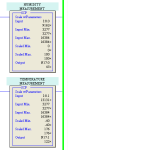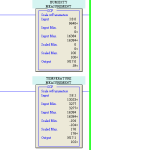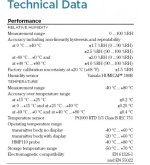You are using an out of date browser. It may not display this or other websites correctly.
You should upgrade or use an alternative browser.
You should upgrade or use an alternative browser.
Help with SCP Instruction....
- Thread starter JoseM
- Start date
-40 degrees C happens to be one of the few temperatures that are the same on both the Centigrade and Fahrenheit scales. If your temperature sensor range is -40 to +80 degrees C, and you want to scale that to degrees F, then the Output Min would be -40 degrees also, and Output Max would be 176 degrees F as you have it.
Also, the Input Min and Max ranges depend totally on which type of Input you are using (Current or Voltage, and Engineering Units, PID Units, or Other). You must configure your Input module to match what types of inputs that you are using for each module input channel.
It appears (just a guess) that you are trying to use the NI4 data format. If so, then you have your humidity input set up for a 0-5 volt or 0-20 mA input and your temperature input set up for a 1-5 volt or 4-20 mA input. I doubt if they should have different ranges, but cannot tell (from what you posted) what range it should be, or whether it should be a voltage or current input.
Also, the Input Min and Max ranges depend totally on which type of Input you are using (Current or Voltage, and Engineering Units, PID Units, or Other). You must configure your Input module to match what types of inputs that you are using for each module input channel.
It appears (just a guess) that you are trying to use the NI4 data format. If so, then you have your humidity input set up for a 0-5 volt or 0-20 mA input and your temperature input set up for a 1-5 volt or 4-20 mA input. I doubt if they should have different ranges, but cannot tell (from what you posted) what range it should be, or whether it should be a voltage or current input.
Last edited:
sthompson
Lifetime Supporting Member + Moderator
Can you guys tell me if I set up these two SCP instructions correctly. Here are pictures of the instructions and the instrument specs.
It would have been helpful if you listed the Make and Model of PLC, and the Analog Input Card you are using.
Stu....
nettogrisen
Lifetime Supporting Member
It looks ok, but we can't see the output range of the transmitter, and we don't know the resolution of your analog input card.
It looks like you have scaled the humidity sensor for 0-20mA or 0-10V and the temperature sensor for 4-20mA or 2-10V.
Why is the scaled max/min of the temperature SCP -104 to 176. The spec says that the measurement range goes from -40 to + 80 deg. celcius?
It looks like you have scaled the humidity sensor for 0-20mA or 0-10V and the temperature sensor for 4-20mA or 2-10V.
Why is the scaled max/min of the temperature SCP -104 to 176. The spec says that the measurement range goes from -40 to + 80 deg. celcius?
Jose is in Texas, so is using Texas temperature units.Why is the scaled max/min of the temperature SCP -104 to 176. The spec says that the measurement range goes from -40 to + 80 deg. celcius?
I think that the -104 is an error and should be -40. The 176 does equal an "F" reading of 80 degrees C.
Sorry guys for not providing enough information and yes, I'm converting to Farenheits. The module I'm using is a 1746-NIO4I and the two inputs are set to 4 - 20MA range. Originaly I set the humidity scaling to,
Input Min: 3277
Input Max: 16384
but the value of humidity I was getting seems that it was to low and that is the reason why I change it to what you see on the picture just to see what it would do.
On the temperature SCP instruction, when I changed the Input Min to -40 the output of the instruction change to 120 F which I know can't be correct. Why is that?
The instruments outputs two 4 - 20Ma signals, one for humidity and one for temperature.

Input Min: 3277
Input Max: 16384
but the value of humidity I was getting seems that it was to low and that is the reason why I change it to what you see on the picture just to see what it would do.
On the temperature SCP instruction, when I changed the Input Min to -40 the output of the instruction change to 120 F which I know can't be correct. Why is that?
The instruments outputs two 4 - 20Ma signals, one for humidity and one for temperature.

Last edited:
Mickey
Lifetime Supporting Member
You need to know what the 4-20ma represents from your transmitter.
Last edited:
TConnolly
Lifetime Supporting Member
Slightly OT, I much prefer SI units and have been frequently critical of the US's intransigence at adopting the SI system. However, IMO, the Celsius scale is one place where the SI system really messed up. The Celsius scale cannot be duplicated at all points on the Earth's surface since it depends on the the boiling point of water and that changes with altitude and even fluctuates from day to day with barometric pressure. The Fahrenheit scale can be duplicated anywhere since it is not dependent on the boiling point of water. On the Fahrenheit scale 0°F is defined as the frigorific temperature of a 1:1:1 mixture of water, ice, and ammonium chloride and the melting point of ice is defined as 32°F. Having thirty-two degrees between the two points allows construction of the scale by bisecting the distance between them - allowing anyone anywhere to reconstruct the scale with simple instruments. The German's got it right with that scale, then abandoned it.
TConnolly
Lifetime Supporting Member
On the temperature SCP instruction, when I changed the Input Min to -40 the output of the instruction change to 120 F which I know can't be correct. Why is that?
Jose,
The Input min should be Input Min: 3277. Input max is 16384. Output Min is -40. And Output Max is 176.
If you are having trouble converting between °F and °C then open your web browser, go to Google, and type "-40C in F" (without quotes) and hit return. Google will make the conversion and show you that -40° is the same in both scales. Then type "80C in F" and Google wiil show you that 80°C is 176°F.
According to the Allen Bradley Analog Input manual, the correct range for the 1746-NI04I module, and set for 4-20mA input, is 3277 to 16,384. Your humidity sensor should read 0 to 100 with those SCP settings. If it does not, you have some other problem. Notice that you do have to set the DIP switches on your module to ON to use the Current range....the value of humidity I was getting seems that it was to low and that is the reason why I change it...
The 1746-NI04I input module is not isolated, so if your humidity sensor needs isolated inputs, you may need to add a Signal Isolator or Signal Converter.
Hot metal surface in the Texas sun in June? 120 degrees F sounds about right! It could be that your RTD sensor built into your humidity device is slightly off, but I bet it is within +/- 10 degrees.On the temperature SCP instruction, when I changed the Input Min to -40 the output of the instruction change to 120 F which I know can't be correct. Why is that?
Last edited:
Here are some more specs Mickey, the instrument is a "Two-Wire" type. Here we should see the resolution of the analog output signal. I took an infrared thermometer and measured the temperature at the probe and it was 100F and also the RH% at the problem with another hand held instrument was 47%, so I'm off by 3% on the humidity.
Lancie1, the DIP switch on the analog module is set to "Current" for the two inputs.

Lancie1, the DIP switch on the analog module is set to "Current" for the two inputs.

Last edited:
Mickey
Lifetime Supporting Member
Have you measured the actual current from the transmitter? To verify the accuracy of the transmitter against some known standard. This will tell you which device is causing the values to be off.
So the RTD temperature is off by about 20 degrees. You may have to adjust your scaling factor Offset to compensate for that, if it is linear across the entire temperature range.I took an infrared thermometer and measured the temperature at the probe and it was 100F
As for the humidity, I am surprised that you got two different sensors to read within 3% humidity!
Things to check:
1. Make sure that your humidity sensor is connected to Input I:8.0, and that the temperature sensor is connected to I:8.1. I know - that could not possibly happen. However, swapped wires have happened to me many times, and it is common and easy to get two wire labels mixed up during the pull-in. It does make a difference in what readings you will get!
2. Disconnect the humidity input and see if the temperature then reads closer to 100 degrees F. If it does, then you need two Signal Isolator cards to insert between your input wires and the PLC input terminals.
Last edited:
I'll check the connections again tomorrow Lancie1 to confirm that there is nothing wrong but I did that prior to setting the SCP instructions on the PLC so I could do the scaling correctly.
I'm curious to see what will happen when I do the test you suggest about removing one of the inputs tomorrow. Do I need to remove the signal and the neutral wire or just the signal?
I'm curious to see what will happen when I do the test you suggest about removing one of the inputs tomorrow. Do I need to remove the signal and the neutral wire or just the signal?
Similar Topics
Hi,
This may seem like a very stupid question to you guys but I am a bit stuck with this. I was playing with my ML1100 and trying to scale an...
- Replies
- 6
- Views
- 2,481
Hi Everyone,
i was hoping for a little help with this module. i have data that needs to be read from a different plc through the Modbus plus...
- Replies
- 9
- Views
- 83
Hello,
I am trying to replicate a piece of logic on the PLC5 onto an SEL RTAC. I am using ladder on SEL and FBD. I am having issue on the ladder...
- Replies
- 9
- Views
- 103
HOW to communicate with OPTIX and Mitsubishi's Q Series PLC?? PLEASE HELP ME
- Replies
- 0
- Views
- 37
I'm fairly new to Rockwell software, I've had some basic training in the past but nothing too advanced. My company and I use Reliable products for...
- Replies
- 11
- Views
- 331






